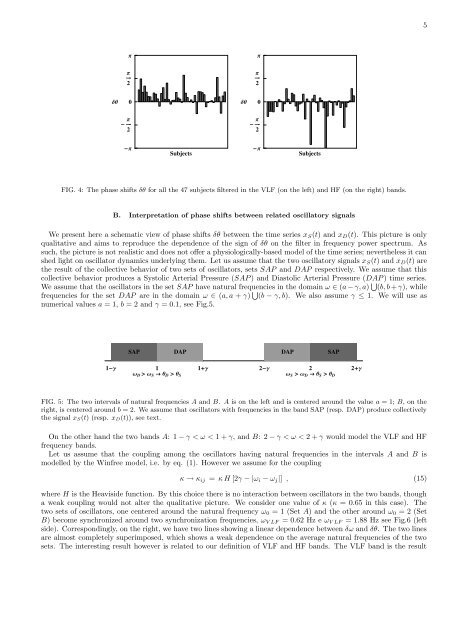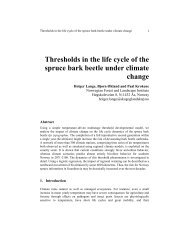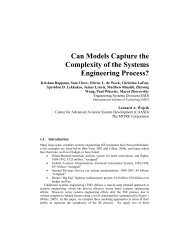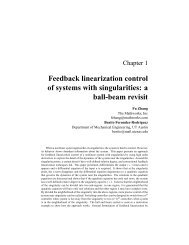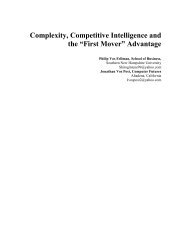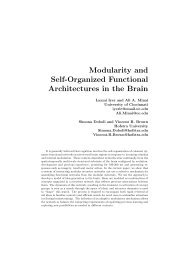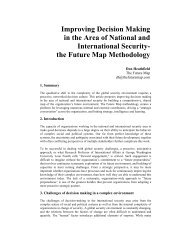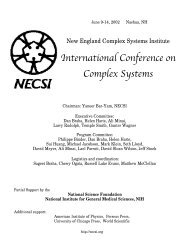Phase shifts between synchronized oscillators in the Winfree and ...
Phase shifts between synchronized oscillators in the Winfree and ...
Phase shifts between synchronized oscillators in the Winfree and ...
Create successful ePaper yourself
Turn your PDF publications into a flip-book with our unique Google optimized e-Paper software.
5ΠΠΠ2Π2∆Θ0∆Θ0 Π 2 Π 2ΠSubjectsΠSubjectsFIG. 4: The phase <strong>shifts</strong> δθ for all <strong>the</strong> 47 subjects filtered <strong>in</strong> <strong>the</strong> VLF (on <strong>the</strong> left) <strong>and</strong> HF (on <strong>the</strong> right) b<strong>and</strong>s.B. Interpretation of phase <strong>shifts</strong> <strong>between</strong> related oscillatory signalsWe present here a schematic view of phase <strong>shifts</strong> δθ <strong>between</strong> <strong>the</strong> time series x S (t) <strong>and</strong> x D (t). This picture is onlyqualitative <strong>and</strong> aims to reproduce <strong>the</strong> dependence of <strong>the</strong> sign of δθ on <strong>the</strong> filter <strong>in</strong> frequency power spectrum. Assuch, <strong>the</strong> picture is not realistic <strong>and</strong> does not offer a physiologically-based model of <strong>the</strong> time series; never<strong>the</strong>less it canshed light on oscillator dynamics underly<strong>in</strong>g <strong>the</strong>m. Let us assume that <strong>the</strong> two oscillatory signals x S (t) <strong>and</strong> x D (t) are<strong>the</strong> result of <strong>the</strong> collective behavior of two sets of <strong>oscillators</strong>, sets SAP <strong>and</strong> DAP respectively. We assume that thiscollective behavior produces a Systolic Arterial Pressure (SAP ) <strong>and</strong> Diastolic Arterial Pressure (DAP ) time series.We assume that <strong>the</strong> <strong>oscillators</strong> <strong>in</strong> <strong>the</strong> set SAP have natural frequencies <strong>in</strong> <strong>the</strong> doma<strong>in</strong> ω ∈ (a − γ, a) ⋃ (b, b + γ), whilefrequencies for <strong>the</strong> set DAP are <strong>in</strong> <strong>the</strong> doma<strong>in</strong> ω ∈ (a, a + γ) ⋃ (b − γ, b). We also assume γ ≤ 1. We will use asnumerical values a = 1, b = 2 <strong>and</strong> γ = 0.1, see Fig.5.SAP DAP DAP SAP1Γ 1 1Γ 2Γ 2 2ΓΩ D Ω S Θ D Θ SΩ S Ω D Θ S Θ DFIG. 5: The two <strong>in</strong>tervals of natural frequencies A <strong>and</strong> B. A is on <strong>the</strong> left <strong>and</strong> is centered around <strong>the</strong> value a = 1; B, on <strong>the</strong>right, is centered around b = 2. We assume that <strong>oscillators</strong> with frequencies <strong>in</strong> <strong>the</strong> b<strong>and</strong> SAP (resp. DAP) produce collectively<strong>the</strong> signal x S(t) (resp. x D(t)), see text.On <strong>the</strong> o<strong>the</strong>r h<strong>and</strong> <strong>the</strong> two b<strong>and</strong>s A: 1 − γ < ω < 1 + γ, <strong>and</strong> B: 2 − γ < ω < 2 + γ would model <strong>the</strong> VLF <strong>and</strong> HFfrequency b<strong>and</strong>s.Let us assume that <strong>the</strong> coupl<strong>in</strong>g among <strong>the</strong> <strong>oscillators</strong> hav<strong>in</strong>g natural frequencies <strong>in</strong> <strong>the</strong> <strong>in</strong>tervals A <strong>and</strong> B ismodelled by <strong>the</strong> W<strong>in</strong>free model, i.e. by eq. (1). However we assume for <strong>the</strong> coupl<strong>in</strong>gκ → κ ij = κ H [2γ − |ω i − ω j |] , (15)where H is <strong>the</strong> Heaviside function. By this choice <strong>the</strong>re is no <strong>in</strong>teraction <strong>between</strong> <strong>oscillators</strong> <strong>in</strong> <strong>the</strong> two b<strong>and</strong>s, thougha weak coupl<strong>in</strong>g would not alter <strong>the</strong> qualitative picture. We consider one value of κ (κ = 0.65 <strong>in</strong> this case). Thetwo sets of <strong>oscillators</strong>, one centered around <strong>the</strong> natural frequency ω 0 = 1 (Set A) <strong>and</strong> <strong>the</strong> o<strong>the</strong>r around ω 0 = 2 (SetB) become <strong>synchronized</strong> around two synchronization frequencies, ω V LF = 0.62 Hz e ω V LF = 1.88 Hz see Fig.6 (leftside). Correspond<strong>in</strong>gly, on <strong>the</strong> right, we have two l<strong>in</strong>es show<strong>in</strong>g a l<strong>in</strong>ear dependence <strong>between</strong> δω <strong>and</strong> δθ. The two l<strong>in</strong>esare almost completely superimposed, which shows a weak dependence on <strong>the</strong> average natural frequencies of <strong>the</strong> twosets. The <strong>in</strong>terest<strong>in</strong>g result however is related to our def<strong>in</strong>ition of VLF <strong>and</strong> HF b<strong>and</strong>s. The VLF b<strong>and</strong> is <strong>the</strong> result


